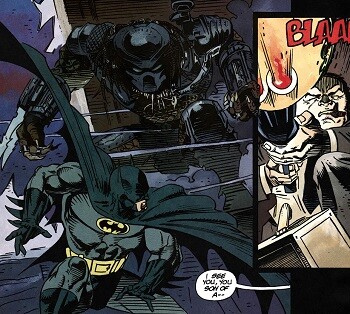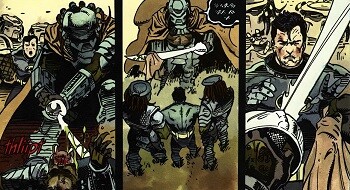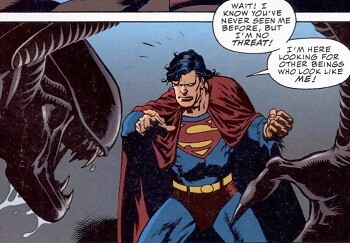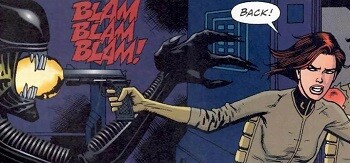Alien And Predator's Best Sequels Were With Batman And Superman

One of the biggest non-sex-related crimes in Hollywood is that no one has managed to create a truly faithful and satisfying continuation to the original Predator or to James Cameron's Aliens. Well, no one in Hollywood itself, anyway. If you're looking for the best sequels ever made for those movies, you have to look at ... some weird Superman and Batman comics from the '90s. Seriously. And it's not even close.
It's kind of insane that a couple of comics of the "licensed crossover" genre (usually the most shamelessly half-assed trash you'd find at your comics store's dollar bin) captured the spirit of these movies better than $100 million productions, but that's the only possible conclusion once you've been introduced to the greatness of ...
Batman Versus Predator (1991)
1. Batman Is The Most Believable Rival To The Predator Since Arnold
It really says something that the most badass adversary the Predators have faced on the big screen since the first movie is 44-year-old Danny Glover, a guy who was already "too old" for Mel Gibson's antics three years prior. Other than that, the movies have pitted these ruthless intergalactic warriors against Adrien Brody, Topher Grace, Key from Key & Pelee, and an autistic 12-year-old. It's always "unlikely action heroes" in the Danny Glover mold because who the hell could measure up to Arnold Schwarzenegger?
Here's who:

DC Comics, Dark Horse Comics
Batman, a man in peak physical condition who pathologically prepares for every possible combat scenario, is the first character to realistically give a Predator a run for its money since Arnold's gang of roided-up mercs from the first movie. Frankly, letting anyone but Batman survive one-on-one rounds with the Predator is an insult to the audience's intelligence. And here's the thing: he still gets his ass kicked.

DC Comics, Dark Horse Comics
Batman only survives by throwing his remote-controlled Batmobile at the Predator, and then spends much of the comic bandaged up from head to toe while an increasingly desperate Commissioner Gordon tries to deal with the Rastafalien butchering whoever he perceives to be Gotham's top dog (from a boxing champion to top gangsters to the mayor). Luckily, the biggest benefit of being rich is that you can build a robot armor for yourself at any point, so Batman does that. After all, the Predator's wearing one too. Which, yes, probably means that the Predators from the movies are bored CEOs and trust fund kids coming to this planet for some excitement between board room meetings.

DC Comics, Dark Horse Comics
Even if you've never seen a Predator movie before, the fact that this thing mopped the floor with Batman and forced him to go all Iron Bat tells you all you need to know about the character. But that's not the only thing the writer (Watchmen artist and co-creator Dave Gibbons) did right ...
2. This Comic Pulls Off The "Predator In The City" Idea Much Better Than Predator 2
Predator 2 is like two movies: one about a police detective investigating a drug war in 1997 L.A. and one about a space monster randomly stabbing dudes. The plot sort of screeches to a halt whenever Danny Glover has to do any actual "detecting," and his slow investigation means it isn't always clear why the Predator picks his victims, making the whole thing feel disjointed. This comic solves both issues with a technique all movies with second act problems should consider: adding more Batman.

DC Comics, Dark Horse Comics
Batman has figured out what's going within the first third of the comic, making his uneasy interactions with the targeted gangsters over the rest of the story feel more organic than Predator 2's messy plot. More importantly, the sequences with the Predator going nuts on the city just work better here, probably because Gotham is a natural fit for ugly creatures with crazy abilities dismembering people in creative ways.

DC Comics, Dark Horse Comics

DC Comics, Dark Horse Comics
And speaking of "crazy" ...
3. The Ending Gets Exponentially Bonkers
One element of the original Predator that none of the cinematic sequels have quite captured is the utter "HOLY @#$%, did that really just happen?!" factor. Luckily, this comic has that in spades. After Batman puts on his armor, he manages to lure the Predator into a trap that drops him down on the Batcave. The Predator eventually turns the tables on Batman and pins him down under his giant decorative penny (which was always a work accident waiting to happen). But then, Batman is saved by what J.R.R. Tolkien once determined to be the prettiest words on the English language: Alfred with a musket.

DC Comics, Dark Horse Comics
Wounded and half-sedated (courtesy of some tranquilizer darts), the Predator tries to escape into the woods outside Wayne Manor, but Batman tracks him down and finishes him off with something he grabbed from the sports room. And that's when we find out that Predators are familiar with both baseball and puns.

DC Comics, Dark Horse Comics

DC Comics, Dark Horse Comics
The comic ends with more Predators coming down in a spaceship, making their loser friend kill himself, and gifting Batman his sword as a souvenir of this adventure.

DC Comics, Dark Horse Comics
On the last page, Batman assures Alfred that the Predators won't be back "now that they've met what lives in Gotham." He underestimated their thirst for a challenge and DC Comics' thirst for money because the comic had two sequels that didn't measure up to the original. But there was another DC superhero/space monster crossover that did ...
Superman/Aliens
1. It Works Shockingly Well As A Superman Story AND An Alien Sequel
This comic had no right to be good. The Superman franchise is all about inspiring humanity through righteousness and resilience; the Alien one is about people being dumb and getting themselves killed by walking penises. This really shouldn't work -- but writer/co-artist Dan Jurgens found a way to tell this story that doesn't just avoid being totally embarrassing but actually stands as a fine installment of both series.

DC Comics, Dark Horse Comics
The story starts with an alien probe crashing on Earth with a message from an asteroid city that's running out of resources. That right there is a genius move because it evokes stuff from both franchises: Superman fans are reminded of Argo, the Kryptonian city that survived the planet's explosion, and thinking "Neat!" -- while Alien fans are reminded of LV-426, the xenomorph-infested planetoid from Aliens, and thinking "Uh-oh."
Superman decides to go to the floating city to help out, but since it's far from any yellow sunlight, the moment he gets there, he starts losing his Superman-ness. By the start of the second issue, he's been blinded after a Xenomorph rudely bled some acid blood on his eyes and has to rely on a young survivor to get around the city's derelict tunnels (which are totally in line with the eerie aesthetic from the movies).

DC Comics, Dark Horse Comics
At one point, Superman realizes that the indisposed survivors he sent on a spaceship back to Earth weren't drunk or something -- they have aliens waiting to burst out of their chests, and he has no way of warning Earth about it. Between that, his diminishing powers, his own eventual infection, and the fact that the asteroid city is literally falling apart, this story has like four ticking time bombs going on at the same time, building up the tension of a nerve-wracking crescendo. And if things weren't hard enough already, Superman goes and makes the mission even harder on himself for the heck of it ...
2. It Puts Superman's No-Kill Code To A Real Test
Early in the story, Superman reminds himself of the time he killed General Zod and paid a huge psychological price as if to say, "Boy, I hope I never find myself in a situation like that again!" And of course, then he goes and lands on an asteroid full of millions of "Zods." Any reasonable superhero would simply punch through the xenomorphs without a second thought, but not Superman -- this adorable dummy actually tries to reason with them ...

DC Comics, Dark Horse Comics
... and, of course, they don't return the courtesy.

DC Comics, Dark Horse Comics
Even then, Superman decides he's not killing a single alien, adding another layer of complication to an already bad predicament. He struggles with his decision several times throughout the story but ultimately reaffirms his position that all life is sacred. Meanwhile, here's Lois Lane back on Earth:

DC Comics, Dark Horse Comics

DC Comics, Dark Horse Comics

DC Comics, Dark Horse Comics
It's actually impressive that the story presents two opposing angles ("even killer monsters deserve to live" vs. "waste the MFers") and makes them both sympathetic. And this isn't even the best thing about it ...
3. It's A Deeply Personal Story For Superman
The biggest tease in the story is through the teen survivor Superman befriends on the asteroid, whose name is Kara. Kara, by the way, was also the name of the original Supergirl, who hadn't been introduced in this continuity yet. And who came from Argo City. And who looked about the same as this Kara, but with a different shampoo brand.

DC Comics, Dark Horse Comics
Superman spends most of the story thinking he might be related to Kara and trying to keep her from falling into despair with his superhuman positivity. Near the end, he finds out that this city didn't come from Krypton -- it came from a planet that worshipped Kryptonians and imitated them in every way (down to exploding, eventually).
But, after all they've been through, Superman tells Kara he still considers her family, and they have a tearful goodbye before going on a suicide mission to escape from the asteroid. Of course, it wouldn't be Alien without something going wrong at the end and everything exploding just as the hero escapes, so that's exactly what happens.

DC Comics, Dark Horse Comics
The story ends with Superman reaching our solar system and powering up just in time to puke out the little alien trying to give him a new orifice from the inside. He saves Lois and the others but is still sad about his "little sister" Kara and wishes she'd made it out instead of him. But then, on the last page, we see that she did make it out and is floating through space in an escape pod, with no way of getting to Earth but alive. This Kara never showed up again, probably due to rights issues since this comic was co-published with another company -- but that might be for the best because any further appearances could cheapen this ending.
You know who did show up again in Superman comics? The aliens, in a pretty unremarkable sequel to this comic, and then again in Superman and Batman versus Alien and Predator (2007), which is officially the moment when the concept of crossovers jumped the shark. But hey, at least it gave us this panel:

DC Comics, Dark Horse Comics
Follow Maxwell Yezpitelok's heroic effort to read and comment on every '90s Superman comic at Superman86to99.tumblr.com.
Top Image: DC Comics